2004 GMC CANYON roof
[x] Cancel search: roofPage 66 of 420
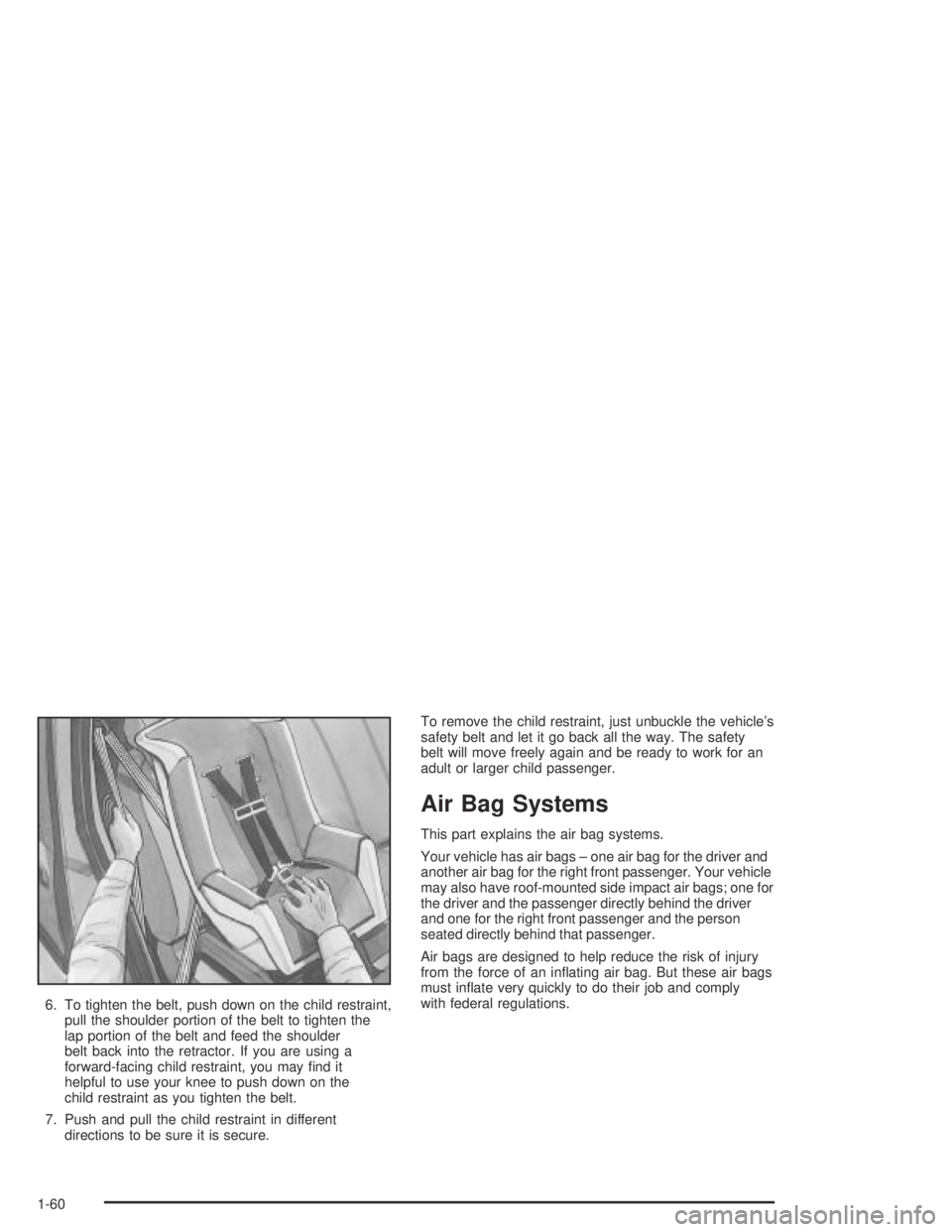
6. To tighten the belt, push down on the child restraint,
pull the shoulder portion of the belt to tighten the
lap portion of the belt and feed the shoulder
belt back into the retractor. If you are using a
forward-facing child restraint, you may �nd it
helpful to use your knee to push down on the
child restraint as you tighten the belt.
7. Push and pull the child restraint in different
directions to be sure it is secure.To remove the child restraint, just unbuckle the vehicle’s
safety belt and let it go back all the way. The safety
belt will move freely again and be ready to work for an
adult or larger child passenger.
Air Bag Systems
This part explains the air bag systems.
Your vehicle has air bags – one air bag for the driver and
another air bag for the right front passenger. Your vehicle
may also have roof-mounted side impact air bags; one for
the driver and the passenger directly behind the driver
and one for the right front passenger and the person
seated directly behind that passenger.
Air bags are designed to help reduce the risk of injury
from the force of an in�ating air bag. But these air bags
must in�ate very quickly to do their job and comply
with federal regulations.
1-60
Page 67 of 420
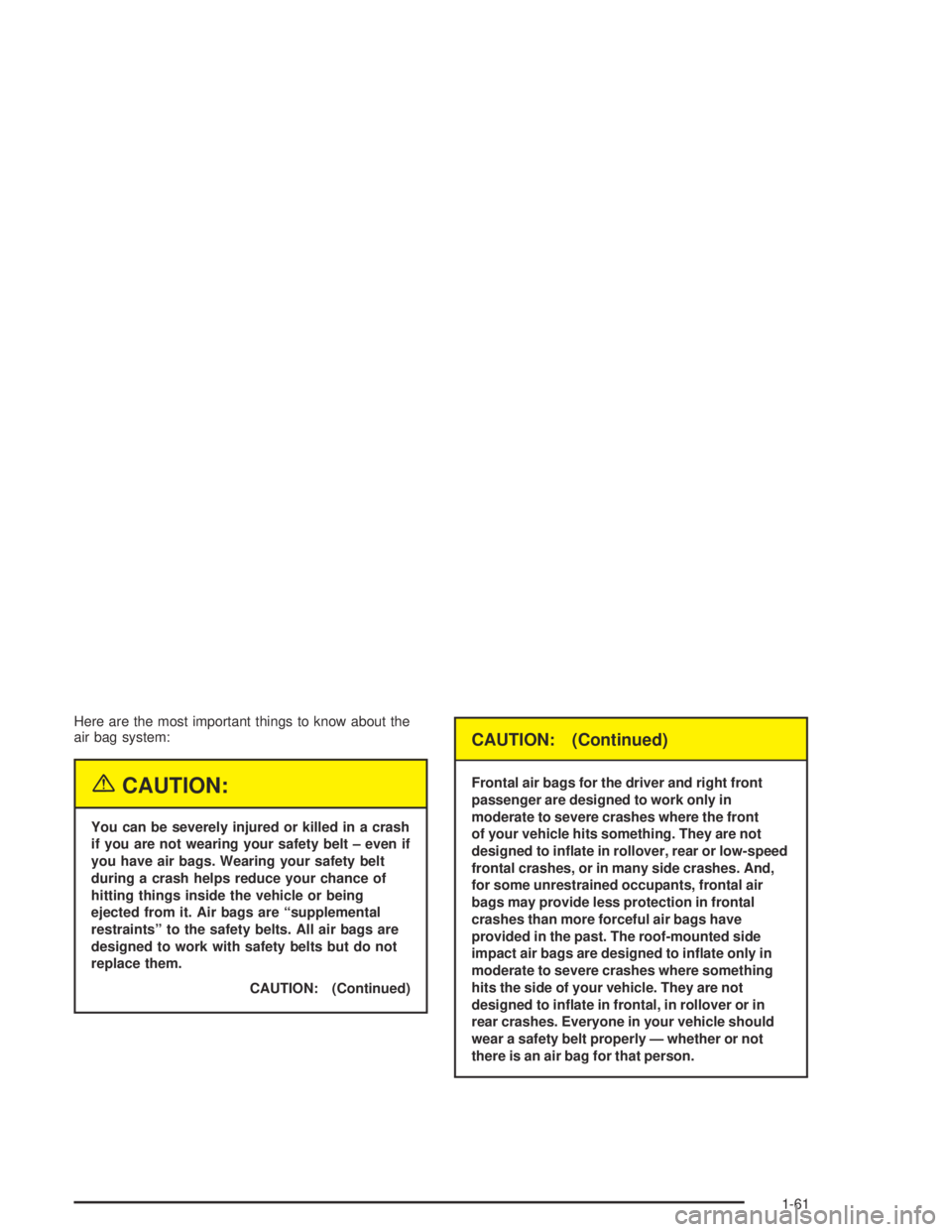
Here are the most important things to know about the
air bag system:
{CAUTION:
You can be severely injured or killed in a crash
if you are not wearing your safety belt – even if
you have air bags. Wearing your safety belt
during a crash helps reduce your chance of
hitting things inside the vehicle or being
ejected from it. Air bags are “supplemental
restraints” to the safety belts. All air bags are
designed to work with safety belts but do not
replace them.
CAUTION: (Continued)
CAUTION: (Continued)
Frontal air bags for the driver and right front
passenger are designed to work only in
moderate to severe crashes where the front
of your vehicle hits something. They are not
designed to in�ate in rollover, rear or low-speed
frontal crashes, or in many side crashes. And,
for some unrestrained occupants, frontal air
bags may provide less protection in frontal
crashes than more forceful air bags have
provided in the past. The roof-mounted side
impact air bags are designed to in�ate only in
moderate to severe crashes where something
hits the side of your vehicle. They are not
designed to in�ate in frontal, in rollover or in
rear crashes. Everyone in your vehicle should
wear a safety belt properly — whether or not
there is an air bag for that person.
1-61
Page 70 of 420

The right front passenger’s air bag is in the instrument
panel on the passenger’s side.If your vehicle has a roof-mounted side impact air bag
for the driver and the person seated directly behind
the driver, it is located in the ceiling above the side
windows.
1-64
Page 71 of 420
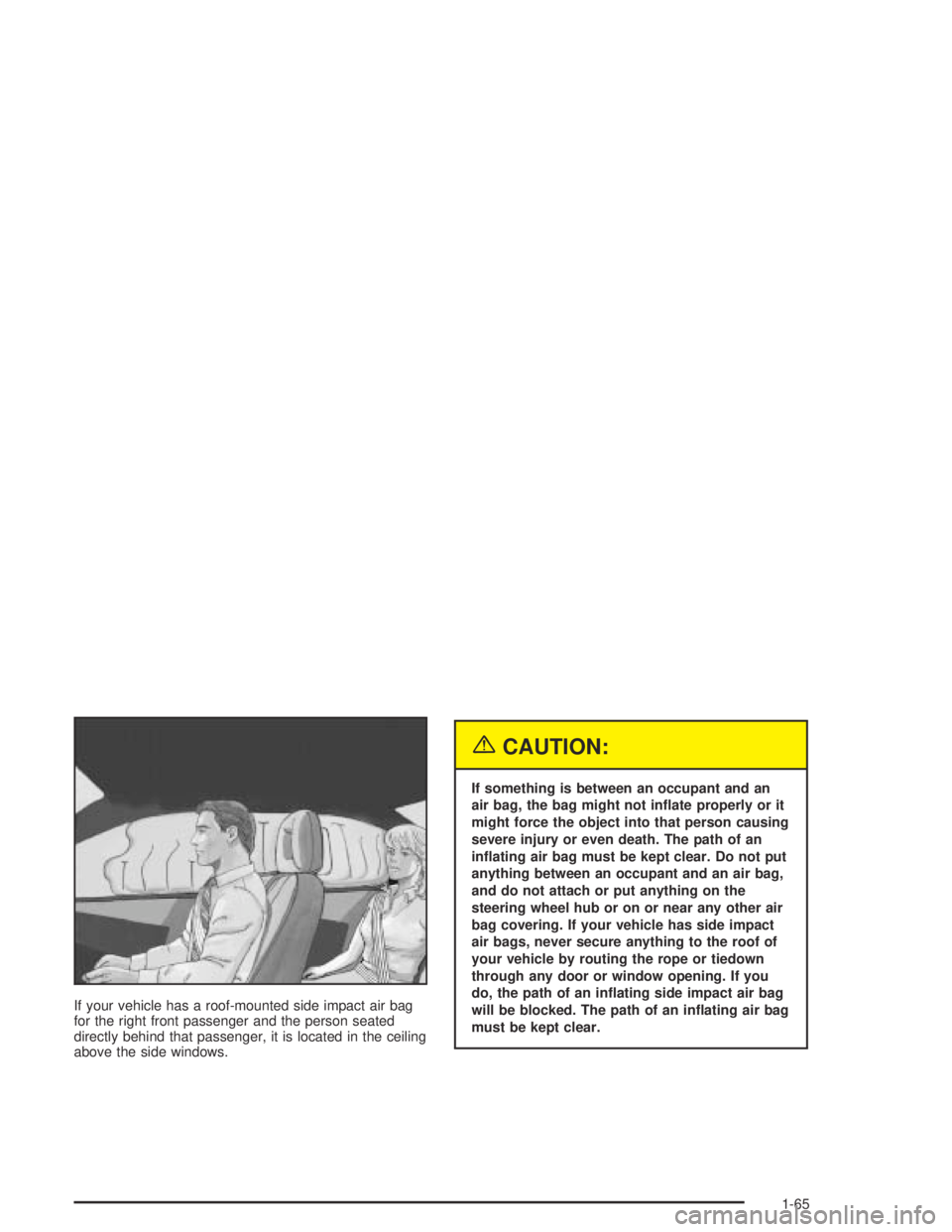
If your vehicle has a roof-mounted side impact air bag
for the right front passenger and the person seated
directly behind that passenger, it is located in the ceiling
above the side windows.
{CAUTION:
If something is between an occupant and an
air bag, the bag might not in�ate properly or it
might force the object into that person causing
severe injury or even death. The path of an
in�ating air bag must be kept clear. Do not put
anything between an occupant and an air bag,
and do not attach or put anything on the
steering wheel hub or on or near any other air
bag covering. If your vehicle has side impact
air bags, never secure anything to the roof of
your vehicle by routing the rope or tiedown
through any door or window opening. If you
do, the path of an in�ating side impact air bag
will be blocked. The path of an in�ating air bag
must be kept clear.
1-65
Page 75 of 420

In many crashes severe enough to in�ate an air bag,
windshields are broken by vehicle deformation.
Additional windshield breakage may also occur from the
right front passenger air bag.
Air bags are designed to in�ate only once. After an
air bag in�ates, you will need some new parts for
your air bag system. If you do not get them, the air
bag system will not be there to help protect you
in another crash. A new system will include air bag
modules and possibly other parts. The service
manual for your vehicle covers the need to replace
other parts.
Your vehicle is equipped with electronic frontal
sensors which help the sensing system distinguish
between a moderate and a more severe frontal
impact. If your vehicle has side impact air bags,
it also has electronic side sensors. Your vehicle is
equipped with a crash sensing and diagnostic
module, which records information about the air bag
system. The module records information about
the readiness of the system and when the systemcommands air bag in�ation. It records the status of
the driver’s safety belt usage in a crash in which
the air bag deploys or a crash in which the air bag
nearly deploys. The module also records speed,
engine rpm, brake and throttle data.
Let only quali�ed technicians work on your air bag
system. Improper service can mean that your air
bag system will not work properly. See your dealer
for service.
Notice:If you damage the covering for the driver’s
or the right front passenger’s air bag, or the side
impact air bag covering on the ceiling near the side
windows, the bag may not work properly. You may
have to replace the air bag module in the steering
wheel, both the air bag module and the instrument
panel for the right front passenger’s air bag, or
side impact air bag module and ceiling covering
for the roof-mounted side impact air bag. Do not
open or break the air bag coverings.
1-69
Page 123 of 420
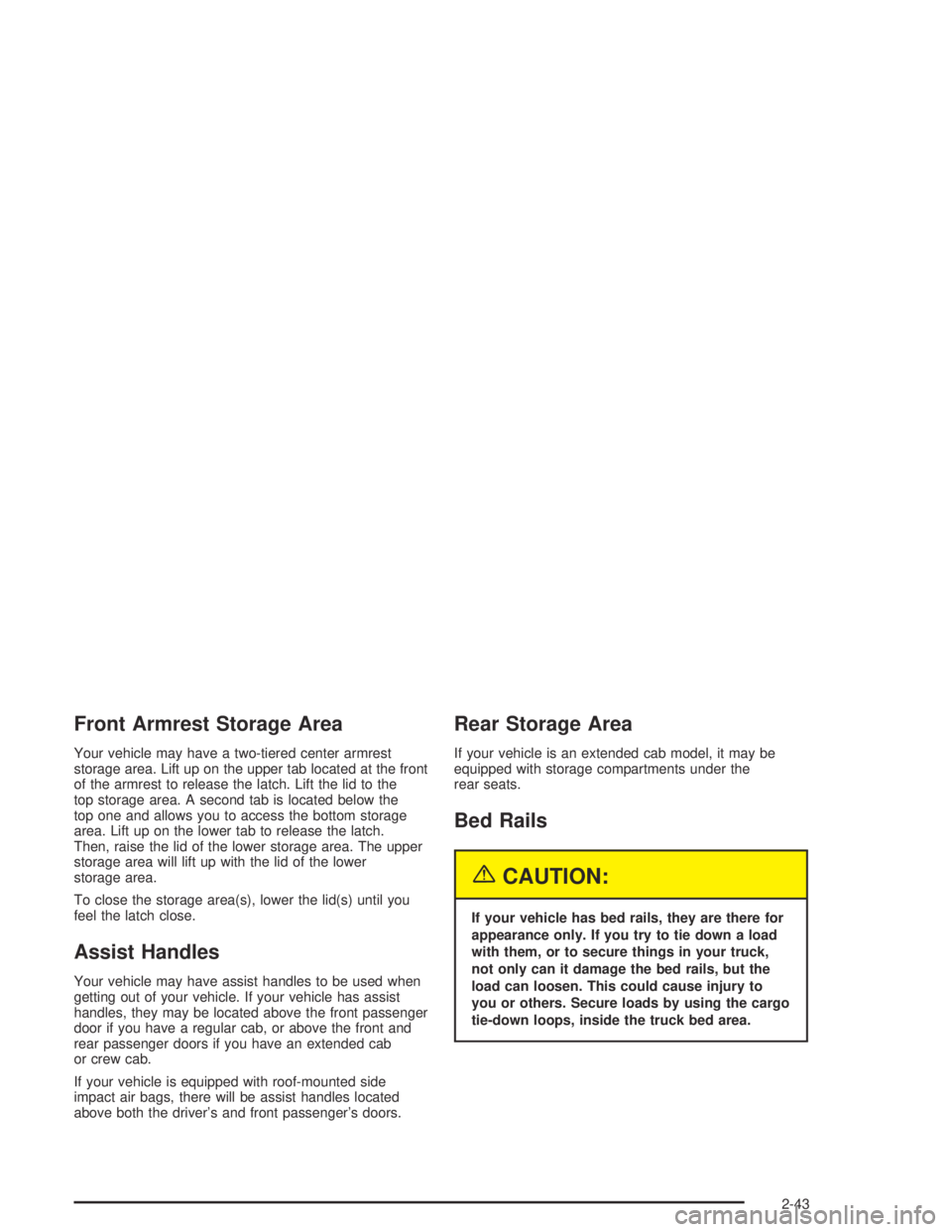
Front Armrest Storage Area
Your vehicle may have a two-tiered center armrest
storage area. Lift up on the upper tab located at the front
of the armrest to release the latch. Lift the lid to the
top storage area. A second tab is located below the
top one and allows you to access the bottom storage
area. Lift up on the lower tab to release the latch.
Then, raise the lid of the lower storage area. The upper
storage area will lift up with the lid of the lower
storage area.
To close the storage area(s), lower the lid(s) until you
feel the latch close.
Assist Handles
Your vehicle may have assist handles to be used when
getting out of your vehicle. If your vehicle has assist
handles, they may be located above the front passenger
door if you have a regular cab, or above the front and
rear passenger doors if you have an extended cab
or crew cab.
If your vehicle is equipped with roof-mounted side
impact air bags, there will be assist handles located
above both the driver’s and front passenger’s doors.
Rear Storage Area
If your vehicle is an extended cab model, it may be
equipped with storage compartments under the
rear seats.
Bed Rails
{CAUTION:
If your vehicle has bed rails, they are there for
appearance only. If you try to tie down a load
with them, or to secure things in your truck,
not only can it damage the bed rails, but the
load can loosen. This could cause injury to
you or others. Secure loads by using the cargo
tie-down loops, inside the truck bed area.
2-43
Page 208 of 420
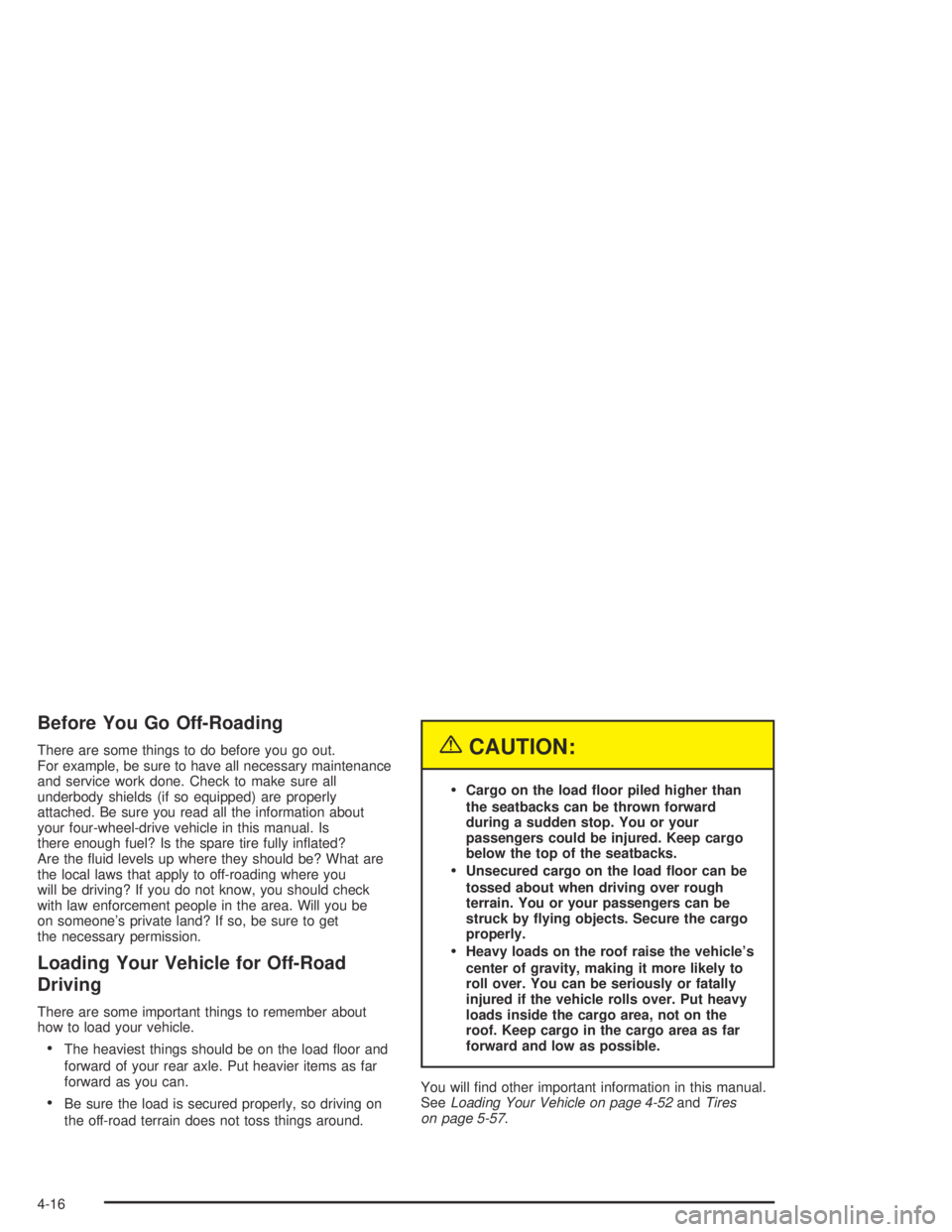
Before You Go Off-Roading
There are some things to do before you go out.
For example, be sure to have all necessary maintenance
and service work done. Check to make sure all
underbody shields (if so equipped) are properly
attached. Be sure you read all the information about
your four-wheel-drive vehicle in this manual. Is
there enough fuel? Is the spare tire fully in�ated?
Are the �uid levels up where they should be? What are
the local laws that apply to off-roading where you
will be driving? If you do not know, you should check
with law enforcement people in the area. Will you be
on someone’s private land? If so, be sure to get
the necessary permission.
Loading Your Vehicle for Off-Road
Driving
There are some important things to remember about
how to load your vehicle.
The heaviest things should be on the load �oor and
forward of your rear axle. Put heavier items as far
forward as you can.
Be sure the load is secured properly, so driving on
the off-road terrain does not toss things around.
{CAUTION:
Cargo on the load �oor piled higher than
the seatbacks can be thrown forward
during a sudden stop. You or your
passengers could be injured. Keep cargo
below the top of the seatbacks.
Unsecured cargo on the load �oor can be
tossed about when driving over rough
terrain. You or your passengers can be
struck by �ying objects. Secure the cargo
properly.
Heavy loads on the roof raise the vehicle’s
center of gravity, making it more likely to
roll over. You can be seriously or fatally
injured if the vehicle rolls over. Put heavy
loads inside the cargo area, not on the
roof. Keep cargo in the cargo area as far
forward and low as possible.
You will �nd other important information in this manual.
SeeLoading Your Vehicle on page 4-52andTires
on page 5-57.
4-16